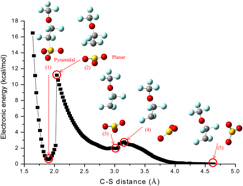Crossref Citations
This article has been cited by the following publications. This list is generated based on data provided by
Crossref.
Ghassemzadeh, Lida
and
Holdcroft, Steven
2013.
Quantifying the Structural Changes of Perfluorosulfonated Acid Ionomer upon Reaction with Hydroxyl Radicals.
Journal of the American Chemical Society,
Vol. 135,
Issue. 22,
p.
8181.
Kumar, Milan
and
Venkatnathan, Arun
2013.
Mechanism of Proton Transport in Ionic-Liquid-Doped Perfluorosulfonic Acid Membranes.
The Journal of Physical Chemistry B,
Vol. 117,
Issue. 46,
p.
14449.
Puchala, B.
Lee, Y.-L.
and
Morgan, D.
2013.
A-Site Diffusion in La1 −xSrxMnO3: Ab Initio and Kinetic Monte Carlo Calculations.
Journal of The Electrochemical Society,
Vol. 160,
Issue. 8,
p.
F877.
Wong, Ka Hung
and
Kjeang, Erik
2014.
Macroscopic In-Situ Modeling of Chemical Membrane Degradation in Polymer Electrolyte Fuel Cells.
Journal of The Electrochemical Society,
Vol. 161,
Issue. 9,
p.
F823.
Díaz, Mariana
Ortiz, Alfredo
and
Ortiz, Inmaculada
2014.
Progress in the use of ionic liquids as electrolyte membranes in fuel cells.
Journal of Membrane Science,
Vol. 469,
Issue. ,
p.
379.
Morgan, Jason M.
and
Datta, Ravindra
2014.
Understanding the gas diffusion layer in proton exchange membrane fuel cells. I. How its structural characteristics affect diffusion and performance.
Journal of Power Sources,
Vol. 251,
Issue. ,
p.
269.
Ghelichi, Mahdi
Melchy, Pierre-Éric Alix
and
Eikerling, Michael H.
2014.
Radically Coarse-Grained Approach to the Modeling of Chemical Degradation in Fuel Cell Ionomers.
The Journal of Physical Chemistry B,
Vol. 118,
Issue. 38,
p.
11375.
Zhang, Weiwei
and
van Duin, Adri C. T.
2015.
ReaxFF Reactive Molecular Dynamics Simulation of Functionalized Poly(phenylene oxide) Anion Exchange Membrane.
The Journal of Physical Chemistry C,
Vol. 119,
Issue. 49,
p.
27727.
Zhao, Yuan-yuan
Tsuchida, Eiji
Choe, Yoong-Kee
Wang, Jian
Ikeshoji, Tamio
and
Ohira, Akihiro
2015.
Theoretical studies on the degradation of hydrocarbon copolymer ionomers used in fuel cells.
Journal of Membrane Science,
Vol. 487,
Issue. ,
p.
229.
Balasubramanian, Sivagaminathan
and
Weber, Adam Z.
2016.
Physical Multiscale Modeling and Numerical Simulation of Electrochemical Devices for Energy Conversion and Storage.
p.
91.
Sepehr, Fatemeh
Liu, Hongjun
Luo, Xubo
Bae, Chulsung
Tuckerman, Mark E.
Hickner, Michael A.
and
Paddison, Stephen J.
2017.
Mesoscale Simulations of Anion Exchange Membranes Based on Quaternary Ammonium Tethered Triblock Copolymers.
Macromolecules,
Vol. 50,
Issue. 11,
p.
4397.
Pant, Rakesh
Kumar, Milan
and
Venkatnathan, Arun
2017.
Quantum Mechanical Investigation of Proton Transport in Imidazolium Methanesulfonate Ionic liquid.
The Journal of Physical Chemistry C,
Vol. 121,
Issue. 13,
p.
7069.
Zhao, Yuan-yuan
Yamaguchi, Makoto
Tsuchida, Eiji
Choe, Yoong-Kee
and
Ikeshoji, Tamio
2018.
DFT Studies of Perfluorosulfonic Acid Ionomer Degradation in Fuel Cells.
The Journal of Physical Chemistry C,
Vol. 122,
Issue. 35,
p.
20135.
Zhang, Weiwei
Dong, Dengpan
Bedrov, Dmitry
and
van Duin, Adri C. T.
2019.
Hydroxide transport and chemical degradation in anion exchange membranes: a combined reactive and non-reactive molecular simulation study.
Journal of Materials Chemistry A,
Vol. 7,
Issue. 10,
p.
5442.
Malek, Ali
Sadeghi, Ehsan
Jankovic, Jasna
Eikerling, Michael
and
Malek, Kourosh
2020.
Aquivion Ionomer in Mixed Alcohol–Water Solution: Insights from Multiscale Molecular Modeling.
The Journal of Physical Chemistry C,
Vol. 124,
Issue. 6,
p.
3429.
Sengupta, Soumyadipta
Lyulin, Alexey V.
Kritikos, Georgios
Karatasos, Konstantinos
Venkatnathan, Arun
Pant, Rakesh
and
Komarov, Pavel V.
2021.
Theory and Modeling of Polymer Nanocomposites.
Vol. 310,
Issue. ,
p.
133.
Huang, Henghui
Xu, Shaoyi
Zhou, Jiexin
Luo, Feiyan
Fan, Jiantao
and
Li, Hui
2021.
Mitigation of chemical degradation in perfluorosulfonic acid proton exchange membrane using regenerable hindered amine functionalized carbon quantum dots.
Journal of Membrane Science,
Vol. 636,
Issue. ,
p.
119614.
Marocco, Paolo
Sundseth, Kyrre
Aarhaug, Thor
Lanzini, Andrea
Santarelli, Massimo
Barnett, Alejandro Oyarce
and
Thomassen, Magnus
2021.
Online measurements of fluoride ions in proton exchange membrane water electrolysis through ion chromatography.
Journal of Power Sources,
Vol. 483,
Issue. ,
p.
229179.
Zhu, Zhenghao
Luo, Xubo
and
Paddison, Stephen J.
2022.
Coarse-Grained Modeling of Ion-Containing Polymers.
Chemical Reviews,
Vol. 122,
Issue. 12,
p.
10710.
Huang, Henghui
Zhang, Xiuping
Fan, Jiantao
Li, Hui
and
Wang, Haijiang
2022.
Expanded polytetrafluoroethylene functionalized with free radical scavengers and hydrophilic groups for superior chemical stability of proton exchange membranes.
International Journal of Hydrogen Energy,
Vol. 47,
Issue. 41,
p.
18109.



